One acre rain hose kits
Grekkon Limited’s one acre rain hose kits in Kenya installations are done by the technical team across the country. The number of rain hose pipes installed per acre is determined by the following:
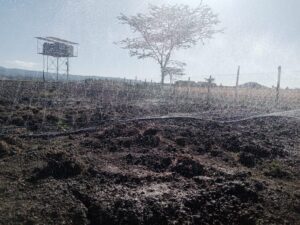
A one acre rain hose irrigation system installed by Grekkon Limited in Makutano area, laikipia county
- the available flow rate, and pumping pressure from the water pump or water source. Where the flow rate and pumping pressure is high, the diameter of reach is broad, so less rain hose pipes are needed
- the diameter of the pipes. Larger diameter rain hose pipes provide more water, over a larger area, so less of them are needed
Cost of one care rain hose kits in Kenya
| Diameter size | Flow rate per 100M | Price in KES |
| 32mm or 1″ | 13 cubic litres per hour | KES 85,000 |
| 40mm or 1-1/4” | 16 cubic litres per hour | KES 78,000 |
| 50mm to 1-1/2″ | 22 cubic litres per hour | KES 70,000 |
Rain hose pipes work under high gravity pressure (from 6M or 0.6bar), and with high volume water pumps. The discharge rate of the water pump is from 40 cubic litres per hour. These water pumps are surface solar, electric, petrol or diesel powered
One acre rain hose kits in Kenya
Installation
- Trench where the poly vinyl chloride (PVC) main line will be laid. This is not necessary for the high density polyethylene (HDPE) which are surface pipes. PVC pipes are sub-surface pipes because they have no UV-treatment, and will thus degrade easily under the sun. HDPE pipes have UV treatment and will be surface pipes
- Connect the PVC or (HDPE) main line to the water pump or high tank. This pipe evacuates water from the source to the farm and is the largest in diameter. The larger the pipe diameter, the more the water it delivers. .
- Join the HDPE or PVC sub-main line to the main line. The sub-main line is smaller in diameter, and so carries less water. It is joined to the main line through PVC or HDPE accessories such as; tees, elbows, saddle clamps, adaptors or valve sockets
- Connect the rain pipe to the sub-main line or the main line where a sub-main line does not exist. This is done with a rain hose connector or a saddle clamp
- Spread the rain hose along the length, and close the terminal end with an end cap
- Connect one rain pipe to another with a connector
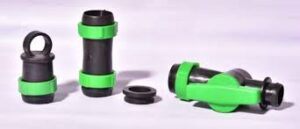
Rain hose fittings from left to right: end cap, connector, rubber, and ball valve
A drilling tool is the only tool used when installing a rain hose kit. This is to create an opening on the main or sub-main line to insert the rain pipe ball valve
One acre rain hose kits
Components of a rain hose irrigation kit?
1. End-caps. They close the end of the pipe to prevent further water flow 2. Starter off-takes. They connect the rain pipe to the PVC or HDPE main line that supplies water to the rain hose from a water pump or highly elevated water tank 3. Pipe connectors. To connect one rain hose pipe to another 4. Mini valves. To control water flow to the rain hose pipe
The diameter of the pipe are; 25mm, 32mm, 40mm and 50mm. A grower chooses the preferred size based on crop water needs and area of irrigation. For instance, a farmer with 1 acre of the crop will comfortably water with the volume delivered through a 32mm rain hose pipe.
Another grower with 5 acres will better irrigate with a 50mm rain hose pipe. An acre of crop uses 1,000 meters of 25mm, 800 meters of 32mm rain hose pipes, 600M of 40mm pipes, and 400M of 50mm pipes
One acre rain hose kits
Rain hose irrigation system requirements
- The system requires a pressure head of 30M, and above
- When using a water pump to power the rain hose irrigation kit, the discharge rate should be from 45 cubic litres per hour
- The rate of water discharge is determined by the diameter size, and number of pores on the rain pipe. For instance, a rain pipe with 5 holes per cluster discharges less water than the one with 7 holes in a cluster
- It irrigates in opposite directions at a radius of 3M for the 32mm pipe, 5M for the 40mm pipe, and 7M for the 50mm pipe
- The vertical height of this water jet is 1M
One acre rain hose kits
FAQs
a. What is the difference between a rain hose irrigation system and a sprinkler system?
- The technology. The rain pipe irrigation system is designed using nano technology
- The mode of spray. A sprinkler sprays its water in one direction, a rain hose pipe sprays in 3 directions (vertically, horizontally, and diagonally)
- Placement. A sprinkler is placed upright on the surface or sub-surface (for pop up sprinklers). A rain hose is laid on the ground
b. What is the pressure in a rain pipe?
The minimum operating pressure is 30M head / 3 bars
c. What is the spacing for rain hose irrigation?
The distance from one rain pipe to another is from 1.5M depending on the operating pressure, and pipe diameter
Grekkon limited is the largest supplier and installer of rain hose irrigation systems in Kenya, and in the east and central Africa region
Micro Sprinklers In Kenya
Micro sprinklers in Kenya by Grekkon Limited are low-pressure, low to medium volume irrigation equipment that are ideal for micro-irrigation. They deliver water directly to the crop root zone, in a uniform manner. They provide full scale surface irrigation, and localised watering of crops. Micro sprinklers are used for; fruit tree, lawn, hedge, and small garden irrigation
Micro sprinkler price in Kenya
The unit cost of all types of sprinkler jet micro sprinklers at Grekkon Limited is from Kes 100 at any of our branches nationwide. Micro sprinkler price per acre is a factor of the number of units used, which depends on the crop spacing. For instance tree tomato spaced at 2M x 2M will require a higher number of micro sprinklers than avocado spaced at 6M x 5M
Each unit is composed of 3 parts; the sprinkler, the 8mm diameter connecting tube, and a 1-1/2′ long plastic support stand
Micro sprinklers save water through high application efficiency, and uniformity of spray. They are a substitute for button drippers where drip irrigation is impractical, but create a larger wetted area than drip irrigation. Micro sprinkler irrigation provides low precipitation which allows for longer watering time with low run-off. They are available in a wide range of plastic configurations. Micro sprinkler sets are used with fertigation systems which save on fertiliser application labour cost. They are also light in weight and small in size, which makes them highly portable, and easy to install
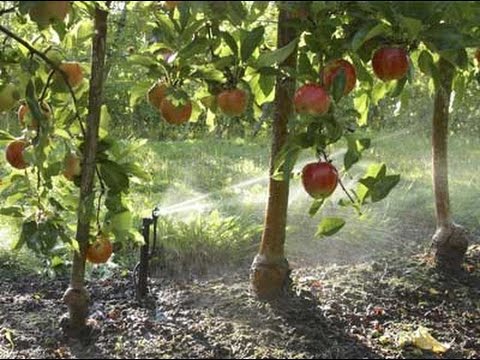
Micro sprinklers watering an apple crop
What is micro sprinkler irrigation?
It is micro irrigation through the adoption of sprinkler jet micro sprinklers, set at the base of the plant
Micro Sprinklers In Kenya
Coverage:
Micro sprinklers coverage is a factor of; flow rate, wetting diameter or radius, and the wetting degree.
1. Operating pressure; from 15M head / 1.5 bar – 20M head/ 2 bar. Pressure lower than this will cause the micro sprinkler to release large droplets, or cease rotation. These droplets will be unhelpful, or even destructive to the work undertaken
2. Flow rate 40 litres per hour
3. Irrigation degree; available as 90, 180, and 360 degrees
4. Irrigation dimeter; 1.5M to 3.5M. This is an important factor to note during installation because it guides on the spacing of one sprinkler jet micro sprinkler to another
Micro sprinklers work when positioned upright, or upside down. Upright when they’re standing on the ground for normal irrigation. Upside down when set in a greenhouse, or open field crop to provide humidity to a mature crop or seedlings. This upside down placement is also for keeping plant foliage moist, or for overhead irrigation.
They deliver irrigation water through micro tubing to a series of nozzles attached to risers. They have small to medium sized droplets with good uniformity of coverage, and lower precipitation rate.

How to space micro sprinklers
Micro sprinklers placement is in such a manner that the sprays overlap. If for instance the irrigation diameter is 1.5M, the distance between micro sprinklers will be 2.25M. This ensures that there are no dry spots in between. An overlap ensures full coverage particularly for lawns, hedges or very closely spaced crops
How to use micro sprinklers with fruit trees
Our micro sprinklers for orchards are installed this way: Set one micro sprinkler per tree, 30cm or 1 foot from the base of the tree trunk being irrigated. Unlike online or button drippers which work well with gravity, a water pump will be necessary when irrigating with many micro sprinklers. This is because they need an operating pressure of 15M – 20M head, which is best achieved by a water pump
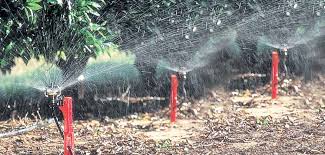
How much water do micro sprinklers use?
They use a maximum of 40 litres per hour
Micro Sprinklers In Kenya
FAQs
1. How effective is micro sprinkler irrigation?
It reduces water usage by 25% to 40% compared to impact or rain gun sprinkler irrigation, and by 45% to 60% when compared to surface irrigation. They provide uniform water application which ensures uniform growth and crop maturity
2. How far apart should sprinkler jet micro sprinkler be?
It should be less than the radius of their spray. See details above under the heading how to space micro sprinklers
3. When do you use a micro sprinkler?
Like drip irrigation, they are great for water conservation. However, unlike drips they create a humid micro climate around the crop, which is important in the control of certain pests such as spider mites, arphids, and thrips,
4. What are the disadvantages of micro sprinkler irrigation?
4.1. The tubes get clogged more easily than those of an impact sprinkler or rain gun sprinkler. This is because they are much smaller than those of other sprinkler types
4.2. They are more expensive to install than drip lines, or button drippers
4.3. They require higher operating pressure than drip lines, or button drippers, hence the need to invest in a water pump
4.4. They require a higher level of expertise during installation than button drippers, or drip tapes
4.5. The rate of water loss due to evaporation is higher than with a button dripper, or drip irrigation system
4.6. Many units are required per unit of land compared to other larger sprinklers
5. How do micro sprinklers work?
They have micro tubings which deliver water to small openings that release it at a slow rate, as fine particles. They apply water directly to the soil surface allowing it to percolate under low pressure
6. How far do micro sprinklers spray?
1.5M to 3.5M diameter
7. What are the components of a micro-irrigation system?
7.1. A pumping station to provide the right pumping pressure
7.2. A filtration system to capture any debris or dirt that will clog the system
7.3. Mainlines. These are the pipes originating from the pumping station, and feeding the sub-main lines. They are the largest pipes
7.4. Sub-main lines. These are the pipes origination from the main lines, and feeding the laterals. They are smaller in diameter than the main lines
7.5. Laterals. These the pipes connecting to the sub-main lines, to which the micro sprinklers are attached. They are the smallest pipes in diameter
These pipes will be either be of the high density polypropylene (HDPE), or poly vinyl chloride PVC type
7.6. Hydrants. These are the irrigation control units in the field from which water is channelled to various blocks
7.7. Venturi system. This is a chemigation and/or a fertigation unit connected to the main line. It is the point from which soluble fertiliser and drenching pesticides are fed into the irrigation system
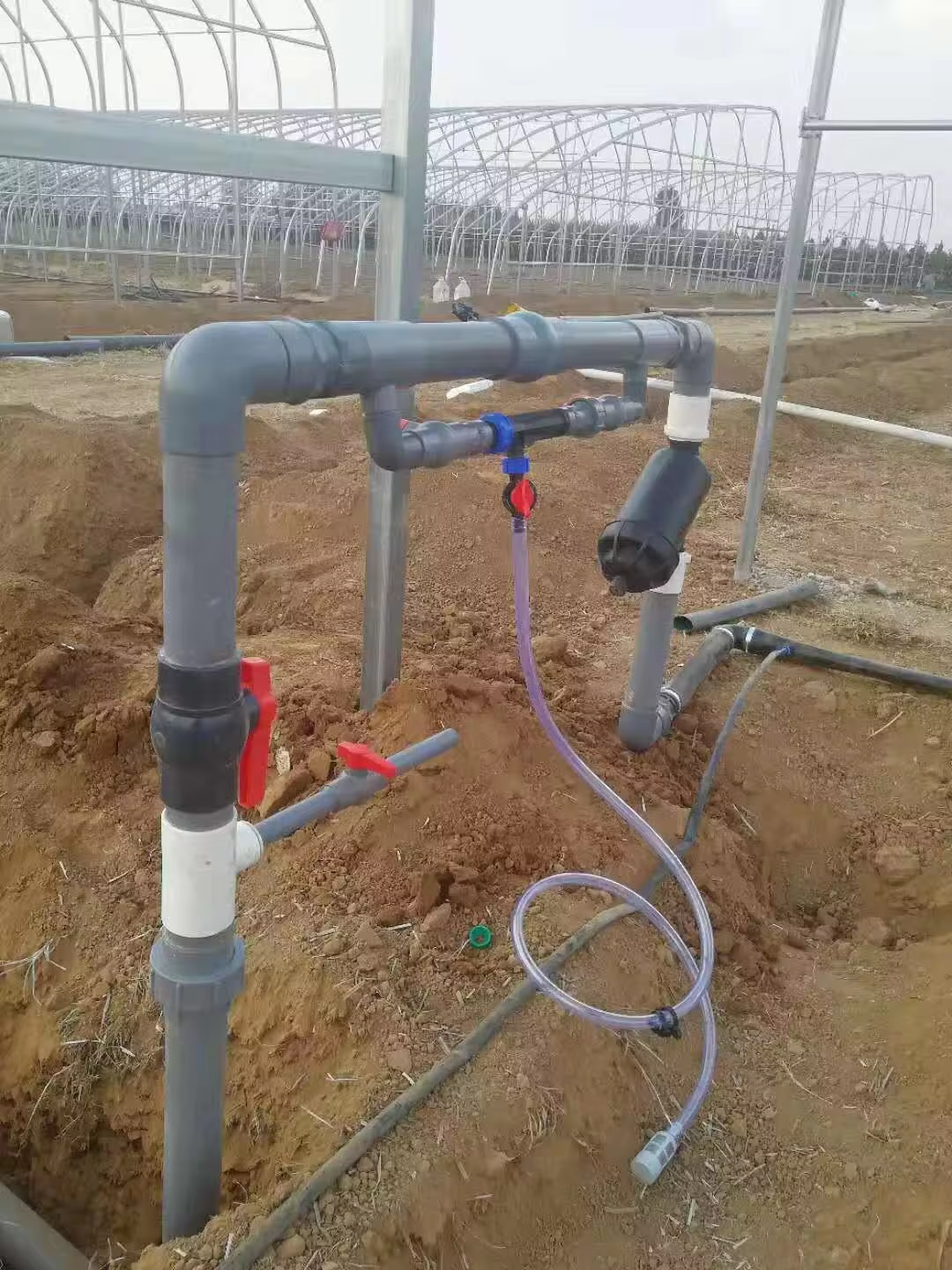
A venturi fertigation – chemigation unit being set up in an upcoming vegetable farm by Grekkon Limited
7.8. The sprinklers. They water the crops directly
8. How long to run micro sprinklers in Kenya?
35 to 45 minutes is sufficient time at optimal flow rate and working pressure
9. What is the difference between drip irrigation and micro sprinklers?
Drip irrigation is for closely spaced crops that require targeted irrigation. Micro-sprinkler irrigation is for sparsely spaced, larger crops or crops that grow best under overhead irrigation
10. What is the difference between mini and micro sprinklers in Kenya?
Mini sprinklers are larger, with a greater flow rate and operating pressure to cover a bigger area. They are better for smaller plants or landscape irrigation
Low Cost Solar Dryers
Grekkon Limited is the largest supplier of low cost solar dryers for agricultural products in Kenya . These low cost solar dryers work on solar strength, and are also augmented with a biomass heat unit if so desired by the client. Our agricultural solar dryers design is according to the product, location, and drying volume per session.
These passive or active solar dryers for fruits and vegetables are fixed or portable as the user needs it. The fixed ones are large and impractical to move about, while the portable one are small domestic drying units
What are low cost solar dryer prices in Kenya by Grekkon Limited?
We price according to size & type. The table below illustrates some sample design pricing for passive solar dryers
| Solar Dryer Size | Drying Capacity | Price of Solar Dryer |
| 1.5m x 1.5m x 1.5m | 40-50kgs | KES 70,000 |
| 2m x 2m x 2m | 50-90kgs | KES 75,000 |
| 2m x 3m x 2m | 80-100kgs | KES 95,000 |
| 2m x 4m x 2m | 90-110kgs | KES 100,000 |
| 2m x 5m x 2m | 100-130kgs | KES 120,000 |
| L X W x H |

Solar dried mango slices
Low Cost Solar Dryers in Kenya
Grekkon limited designs and constructs both passive/ natural circulation, and active/ forced circulation low cost solar dryers for agricultural products. The passive solar dryers have no additional mechanical input, while the active dryers do. Active solar dryers are also know as hybrid solar dryers. Their additional mechanical inputs are; a biomass heating unit, or solar powered exhaust plus extraction fans, and synchronizers. A hybrid solar dryer will have one (solar system or biomass heater) of these enhancements, or both. These enhance drying time by 30% to 100% compared to passive drying. Attached biomass heating units allow for night time drying, or on cloudy/ rainy days.
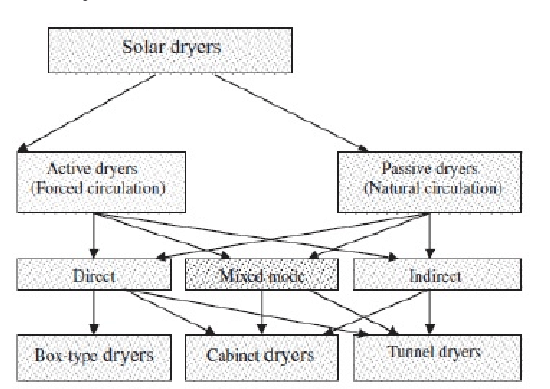
Solar Dryer Materials
- Light UV treated translucent polythene paper to allow heat and light. The paper also has anti-drip treatment to prevent dew formation which causes moulds to form on food
- Heavy UV treated geomembrane to conserve heat
- Steel bars galvanized with food-grade aluminum or zinc for food safety
- UV treated heavy gauge netting to prevent insect pests from entering

A simple portable solar dryer under construction by the Grekkon technical team at Rusinga Island, Homa Bay county. The local community will dry bananas for processing into flour
Below are 2 videos: The first one is of a farmer in Homa-bay county, western Kenya using a community passive/ natural circulation solar dryer to add value to banana produce. The second one is of a mango processor in Taita Taveta county at the county’s coast with an active/ forced circulation dryer. Both solar dryers are by Grekkon Limited.
Video 1. Video 2.
Our low cost solar dryers have shelves at different levels depending on the volume or weight of food crops to dry per session.
Low Cost Solar Dryer Design
What is the working principle of a solar dryer?
1. Passive/ Natural Circulation Food Solar Dryer
Grekkon Limited solar dryers work in the following steps;
i. Capture & collect the sun’s heat
ii. Create a ‘greenhouse effect’ which causes moisture loss from the produce
iii. Air coming into the dryer exits with this moisture from the vent
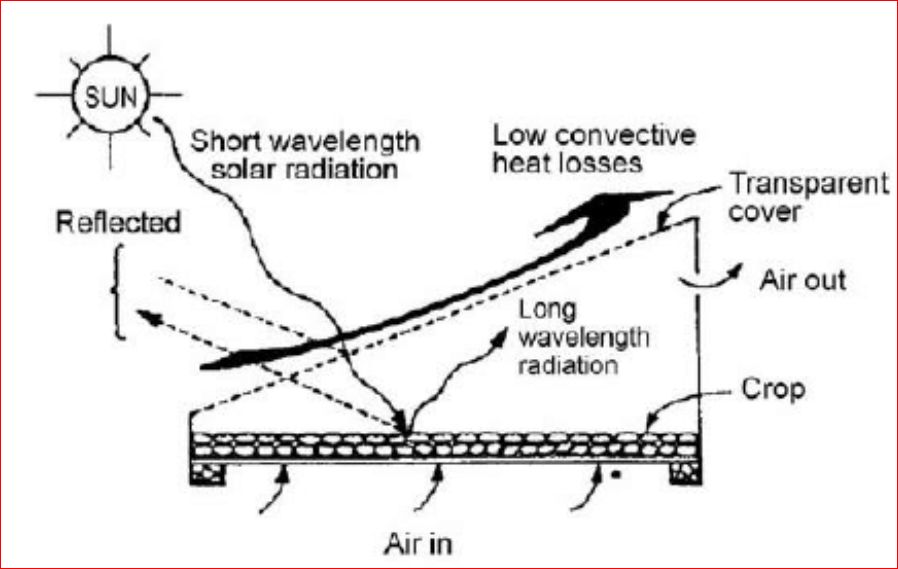
2 Active/ Forced Circulation Food Solar Dryer
In addition to what takes place in the passive solar drying unit, the fans force in hot air from outside, and force out hotter air combined with moisture from inside the dryer. At night or on cloudy/ rainy days, the biomass unit supplies the drying heat.
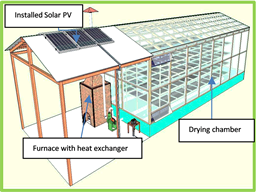
Pros and cons of a low cost solar dryer in Kenya
- Speed of drying. Food dries four to five times faster.
- Quality. As the sun’s UV rays do not get into direct contact with the drying food, the food’s; color, taste, scent, and nutritional value is unaffected
- Cleanliness. The food is free from dust, sand, or other external contaminants
- No pests. Insect, bird, or mammalian pests have no access to food in the dryer, so no attack occurs
- It is more expensive to build and maintain than open-air drying

Solar dried chilli peppers
Low Cost Solar Dryers
FAQs
I. What are solar dryer prices in Kenya by Grekkon Limited?
We price according to size & type. The table below illustrates some sample design pricing for passive solar dryers
II. How does a vegetable dryer work?
- Heat
They allow in diffused heat from the top and the sides, which heats up the air coming in from the air inlet. This hot air will exit with moisture in the air outlet.
- Anti-drip management
Our UV treated polythene cover has anti-drip properties so water droplets do not form on it. It prevents dripping on the drying food which is a precursor for fungal development.
III. What do a low cost solar dryers do?
Grekkon Limited’s solar dryers reduce the moisture content to less than 12% in these products;
- Plantation crops; coffee, rice, cassava
- Vegetables; tomato, onion, garlic, brassicas, hot peppers
- Cereals; sorghum, and millet
- Herbs; moringa, mint, rosemary
- Oil crops; groundnuts, sunflower, macadamia, cashew nuts
- Others; mushrooms, fish, beef, mutton
IV. How do you dry vegetables with solar?
- Wash the vegetables to remove all dirt
- Ensure there are no insect pests present
- Remove any diseased parts or produce
- Cut or grind them into smaller pieces to increase the drying surface area
Place them in the solar dryer holding trays
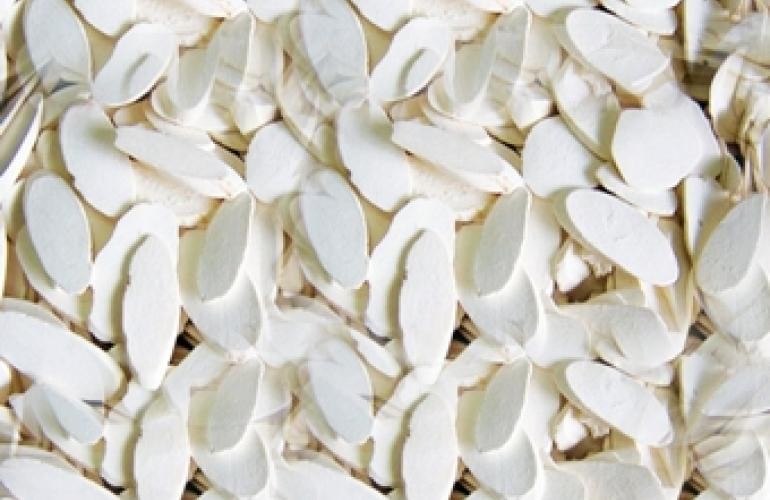
Dry cassava chips
V. What is the most popular use of low cost solar dryers?
To dry fruits, mushrooms, vegetables, herbs, spices, coffee, cassava, banana and fish. Banana and cassava are further processed into food flour. A solar dryer ensures that the food is free of any external contamination
VI. What are the main applications of a solar dryer?
Besides vegetables and fruits, commercial solar dryers in Kenya are for fish, root crops and mushroom drying. Commonly dried foods in Kenya through our solar dryers are:
i. Banana, cassava, pumpkin, millet, and sorghum to make food flour. Dried cassava is also processed for industrial starch manufacture
ii. Moringa as a medicinal herb
iii. Tomato, capsicum, traditional vegetables, kales, and spinach as vegetable nutrients
iv. Mango, papaya, as dried fruits for snacking
v. Omena which is the silver cyprinid fish for both human consumption, and as additive to animal feed
vi. Coffee so that it’s suitable for milling. Coffee solar dryers are the largest, each holding over 5 tons of berries per drying session
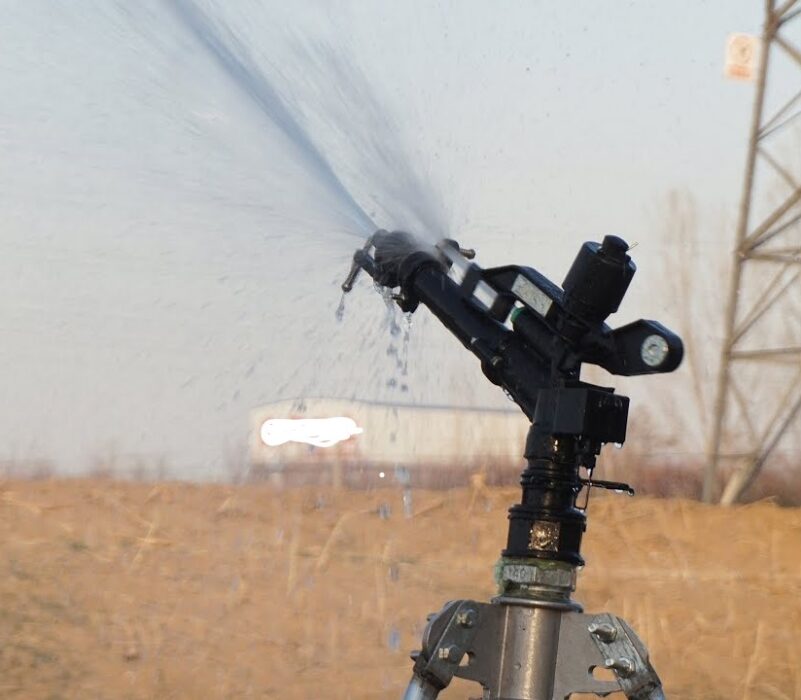
Plastic Rain Gun Sprinkler
Our plastic rain gun sprinkler in Kenya is the Shrub body style whose application is both domestic and industrial. Grekkon Limited’s low pressure plastic rain guns are 1-1/2″ in size. It is a double nozzle with additional detachable nozzles as; 6mm, 8mm, 12mm, and 16mm
This irrigation sprinkler is lighter than it’s metallic counterpart, but with a shorter longevity. It makes it highly portable to reach any point in your farm. It is black in color because it is made from high density polyethylene material (HDPE). This material is UV- treated to reduce it’s degradation by the sun, thus extending the sprinkler’s working life. UV treatment is an important quality in tropical climates where radiation is high. Every tropical grower ought to consider this because it impacts the working life of the rain gun sprinkler
This irrigation rain gun for sale works with water pumps to provide requisite pressure. The necessary water pump specs are:
- It will be electric, diesel or petrol powered
- It must provide a minimum pressure of 3 bars,and a discharge of 8 cubic liters per hour
- The outlet pipe is 1-1/2″ and above. A delivery, HDPE or PVC irrigation pipe evacuates the water from the pump to the sprinkler.
The rotation is up to 360 degrees. A farmer will adjust the rotation area manually as necessary using the pins below the nozzles. All metallic parts are rust proof and the rubbers are easy to replace once they wear out. Our plastic rain gun sprinkler features a friction collar and a trip lock, and are also provided with a jet breaker for uniform water application
Types of rain gun sprinklers
1. Plastic
2. Metallic; PY type, Atom and the flange type rain gun sprinklers. Learn more here; https://grekkon.com/rain-gun-sprinklers-2/
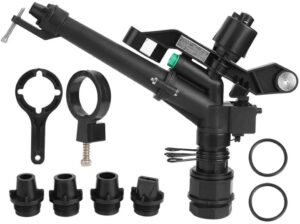
Plastic Rain gun sprinkler specifications and price
| Type | Body Type | Inlet Diameter | Max Spray Diameter | Min Head (Pressure Rating) | Max Flow Rate | Price in Kes |
| Plastic | Shrub | 1.5″ | 30M | 25M | 7M3/ Hr | 5,000 |
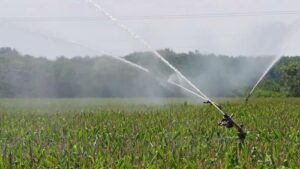
Plastic Rain gun
Product benefits
- This is ideal for newly cleared areas
- It reduces irrigation time
- Low labour cost
- High efficiency
- Improves humidity or creates a micro-climate
- It is easy to maintain and use
- Irrigates a much wider area than conventional smaller impact sprinklers
Disadvantages of rain gun irrigation
- It consumes a large amount of water
- The need for a high amount of power makes it costly to operate
FAQs
1. How much horsepower (Hp) is required for a rain gun?
This depends on the rain gun sprinkler size. The larger it is, the greater the discharge, and so the greater the power needed. Another factor is the number of rain guns set to run at a go. Generally, it is from 8.5Hp
2. Is rain gun good for irrigation?
Yes it is. However, do not irrigate on crops that are highly susceptible to fungal infections with overhead irrigation. Examples are; tomato, potato, capsicums, and others
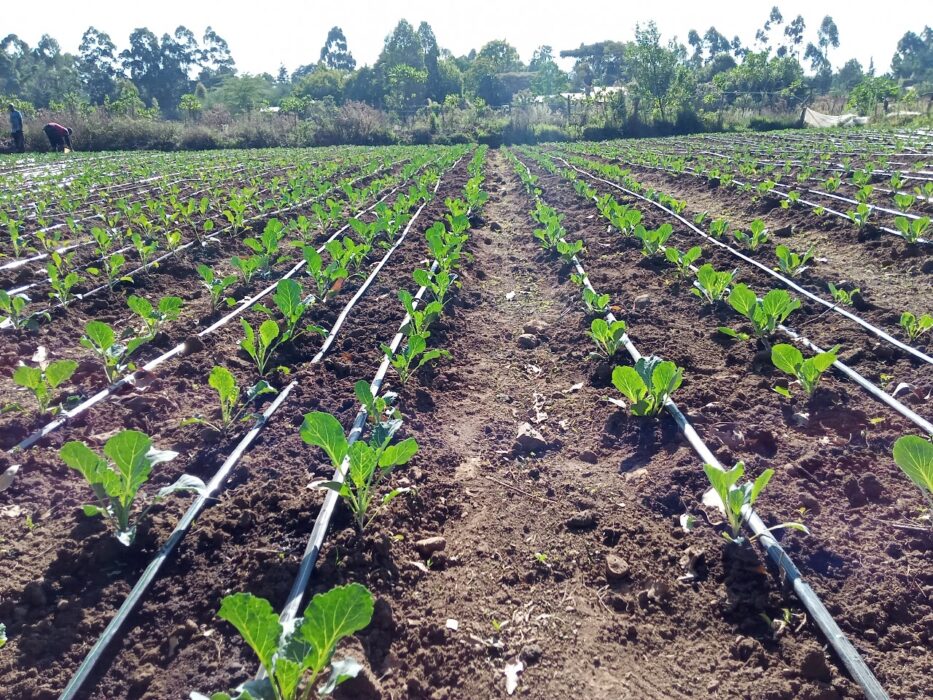
Drip Irrigation System Layout
Grekkon Limited’s drip irrigation system layout is done for all farm sizes, and all crops. There 3 ways in which the company gathers data to develop a drip irrigation system layout
- Farmers provide detailed sketches as directed by the company from which a drip irrigation system layout is developed. This sketch will include; the farm dimensions in meters, the water source type, distance to the water source from the farm, details of any existing irrigation infrastructure, any existing roads or pathsways, any none farmable sections (rocky areas, wet lands, built up locations etc), planting beds layout, the direction(s) of slope, and the total vertical elevation
- Provide the farm’s map coordinates from which the company assesses the farm layout using satellite technology
- Conduct a physcal site assessment visit. This is only carried when 2 above cannot be done
The company only charges for the 3rd service to cover the logistical costs


A sample drip irrigation system layout for a 40 acre farm by Grekkon Limited
The company’s irrigation engineers will conduct a physical visit on a prospective farm to determine the following
i. The water source. The company measures the water volume, and analysis the quality. The volume determines the irrigation system to use, the size of the water pump, and the acreage covered. For intance, a farmer with a borehole yielding 15 cubic litres per hour is best positioned to irrigate using drip irrigation. His irrigated acreage will not exceed 30 acres for optimal water utilisation. On the other hand, a farmer by a large permanent river or lake water source will irrigate hundreds of acres using any irrigation method preferred. The water quality determines the type of filtration system to install.
A screen filter is for water under low pressure with a negligible amout of suspended dirt or other particles. A disc filter is preferred for water under high pressure, with a negligible to a modest amount of suspended dirt orcother particles. A sand filter is for dirty water under high pressure

A simple drip irrigation kit by gravitational flow system layout
ii. The dimensions of the farm in meters. to provide the total acreage. The acreage will determine the pipe diameter sizes, the water pump’s flow rate, and the sub-division of the irrigation blocks
iii. Slope. The elevation of the farm gives the vertical head or lift needed. This is important in determining the pressure rating of the water pump to install, the pipe diameters, the planting beds layout (these should be done against the slope), and the size of the irrigation blocks
iv. Any existing irrigation infrastructure; to determine what can be used or incorporated into the new system
v. Provide advise on security measures for key company installations such as; large water pumps, solar modules, solar inverters, control panels, cables, and other high value accessories
Key Requirements To Install A Drip Irrigation System
1. A water source
2. A water pump and piping mechanism to move this water from the source to the tank or directly to the drip irrigation system.
3. Water storage tank if you’re using gravity to irrigate
4. A tank connector
5. Pipes for the mainline and sub-main line.
6. Mainline and sub mainline fittings
7. Drip irrigation water filter
8. Drip irrigation pipes
9. Accessories
10. Ball valves
Steps To Follow In Designing A Drip Irrigation Layout
- Determine where the water pump or water tank will be placed. Water tanks are used for small acreage gravity flow irrigation, and should be placed at highest elevation to allow ease of water flow by gravity
- The main line originates from the water tank or water pump. The size of the main line determines the volume of irrigation water delivered to the farm in every irrigation session. The larger the farm, the greater the diameter of the mainline
- The water filter is connected along the main line
- A venturi fertigation system where needed is along the main line. The venturi fertigation system is a chemifertigation centre that allows drenching of chemicals and fertiliser through the drip irrigation system
- The air release valves are along the main line. Air release valves are installed where the water pressure is high. This is in steep elevations, or if the water is chanelled via a high pressure water pump. They prevent air locks in the irrigation system. Air locks dramatically reduce, or cease water flow in the system
- A sub main line will be connected to the main line along its way using hydrants. Hydrants are points from which irrigation in a block is controlled from. They can be automated using solenoid valves, or manually operated through ordinary valves. The decision to have sub main lines is a factor of the farm size. In small drip irrigation set ups, the drip pips are directly connected to the main line. In larger acreage, the drip line originate from the sub mainline
- The main line is always larger in diameter than the sub main line. The diameter of the sub main line is determined by the size of the main line. The larger the latter, the larger the sub main line is
- The hydrants are positioned at the beginning or end of every irrigation block
- Planting beds are done against the slope. This is to slow down erosion, and allow better water percolation in the soil during the rainy season. The width of the planting bed is determined by the crop type
- Drip lines lie along the length of the planting beds. The number of drip lines per bed depends on the crop type. E.g 2 drip lines are installed for tomato, 3 drip lines for onion or garlic, and 4 drip lines for some herbs and spices

A 3 row drip layout per bed installed in Birikani area of Kajiado county
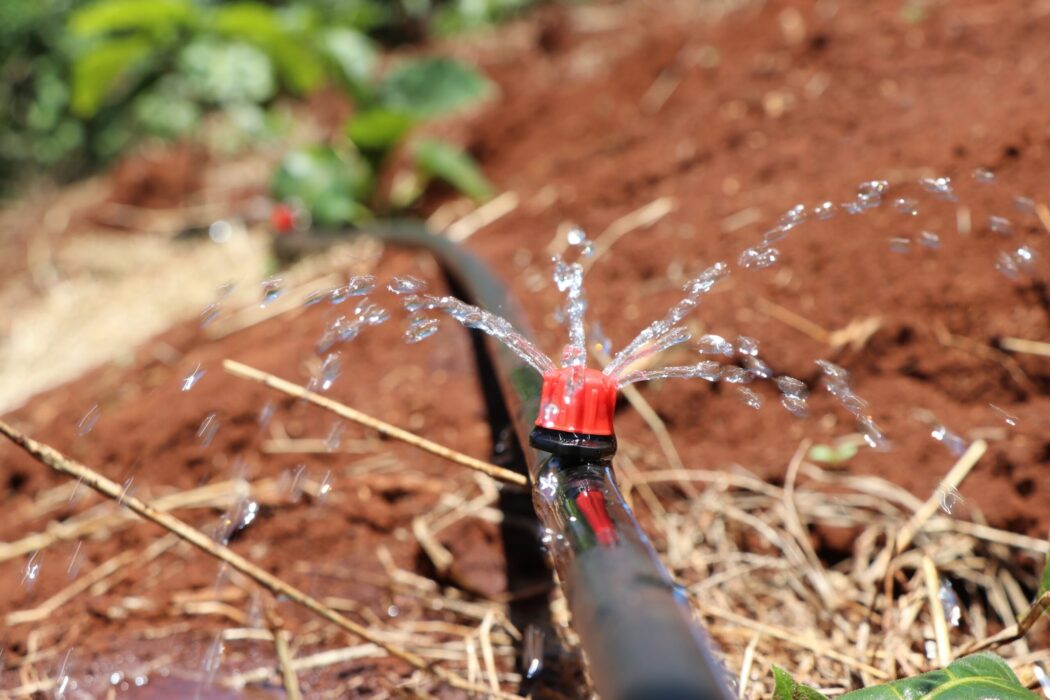
Adjustable Button Drippers For Irrigation
1. What is a button drip emitter?
Adjustable button drippers for irrigation are irrigation accessories attached onto a high density polyethylene (HDPE) pipe.
They deliver a consistent and uniform amount of water the crop by regulating the flow. Button drippers in Kenya, button drip are common in fruit trees, forestry and hedges irrigation
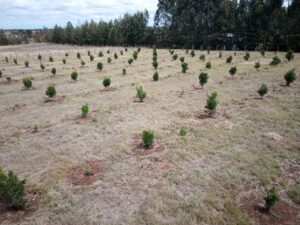
A macadamia crop under button drip irrigation installed by Grekkon Limited in Iten area, Elgeyo Marakwet county. January 2021
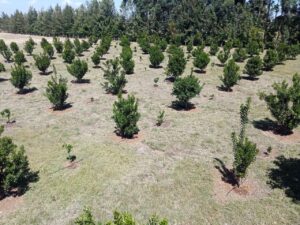
Same macadamia crop in January, 2023
2. How do you install button drippers?
A perforation is made on the HDPE pipe with a drip punch, then the button dripper’s pointed end is pushed into this hole. This punching is done at the point where the tree crop is. But it will be away from the trunk to ensure that water flows to the roots below. The button dripper will be 3-6 inches away from the trunk. This will also prevent fungal infections and other types of diseases.
For younger tree crops, a single button dripper or emitter is sufficient. However, with older larger trees, 2 or more button drippers are provided according to the plant’s water need. In this case, have them equally on the opposite sides of the tree crop to promote even root growth. Two or multiple button drippers ensure that if one is blocked, the other one or the rest continue to water
3. How do you use an adjustable button dripper?
Once in place on the irrigation line, you will adjust your button dripper from 0 discharge to 70 liters per hour flow of water. This is done by turning the dripper to achieve different flow rates as per the crop water needs
4. How long should button drippers run?
Your adjustable button drippers for irrigation will run for 30 minutes to an hour. This is guided by the moisture requirement of the soil, as per the prevailing weather conditions
5. How many button drippers can I run on one line?
This is determined by the diameter size of the irrigation pipe. The larger it is, the more water it ferries over a longer distance. Therefore, the greater the number of button drippers. The other factor is the flow rate of the adjustable button drippers themselves. If adjusted to maximum flow rate (70L per hour), then the line will have less. If the adjustment is to half of that flow rate, then a similar line will carry twice as much
6. How do I increase the pressure in my button drip irrigation system?
They are several ways to raise the irrigation water pressure in your button drip irrigation system
i. Divide the farm into blocks, each of which is irrigated separately. This way, irrigation water is channeled to particular block under high pressure
ii. If it is by gravity flow, then by raising the storage elevation. This will work where raised water tanks are the source of irrigation water
iii. By introducing an external source of pressure, such a s water pump to boost the flow of irrigation water in the system
Adjustable button drippers for irrigation price in Kenya
The cost of a button dripper is Kes 12 a unit
The cost of a button dripper irrigation system per acre depends on the tree crop spacing. In the tabulation below, we provide 3 examples
| Avocado | Passion / Paw Paw | Apple / Tree Tomato | ||
| Spacing | 5M x 5M | 3M x 3M | 2.5M x 2.5M | |
| Cost per Acre | Kes 85,000 | Kes 100,000 | Kes 115,00 | |
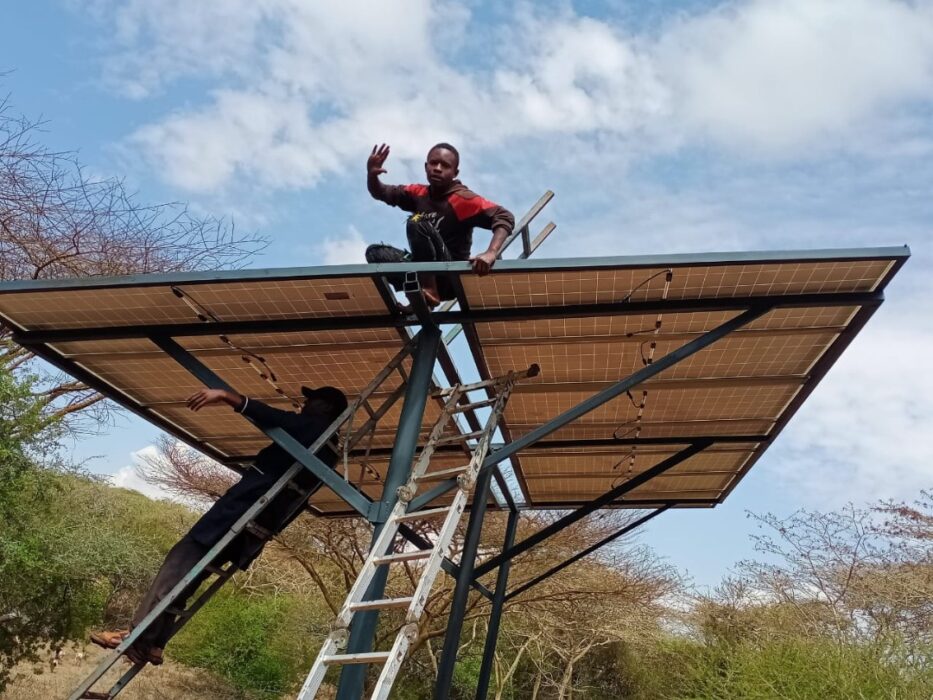
Solar Dryers For Fruits And Vegetables
Grekkon Limited’s hybrid solar dryers for fruits and vegetables in Kenya are designed to dry faster than the conventional or natural solar dryers. They are enhanced with cyclone roof top vents, and fans on the sides. Hybrid solar dehydrators are efficient for large- scale commercial food drying. This is especially with longer to dry fleshy food like; cassava, banana, tomato, fruits, and rice. Drying time is a factor of the food crop type, and the prevailing ambient temperature during the drying period. The quality of the dry produce is consistent. The dryer works through the greenhouse effect.
Solar Dryers For Fruits And Vegetable In Kenya
Solar Dryer Materials
- UV treated paper on the sides and roof. UV block treatment on the polythene paper extends it’s usable lifetime to 4 years. This treatment prevents UV degradation of the food crop. The polythene paper has anti-drip properties to keep dew from forming on the inside of the paper. Dew drops on the drying food will cause molding.
2. Galvanised steel support structure. Galvanised with food grade aluminum, or zinc
3. Concrete floor for the permanent/ immovable models
4. Heat absorbing and releasing dam liner to line the floor
5. Roof top cyclones. Ensures the air is evenly distributed within so that there are no air pockets. This results in evenness of drying for the produce. We install cyclone roof top vents from a particular solar dryer size
6. Fanning system. This comprises of;
- solar panels; to provide electric DC power
- a control box; to regulate electric current
- an inverter; to convert DC energy form the solar panels to AC to power the fans
- fans; an extraction fan to allow push in air, and an exhaust fan to move out accumulated moisture
7. Nets. High density UV treated nets on the air entry and exit points
8. Drying trays designed with material specific to food drying
Every material used is specific to solar dryers for fruits and vegetables to provide; efficiency, safety, and food quality
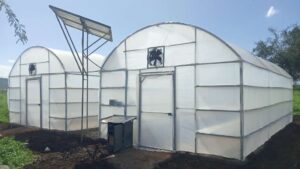
Solar drying units by Grekkon Limited in Taita Taveta county enhanced with a solar panel and battery to power cyclones, extraction and exhaust fans. They increase air movement in the solar dryer, thereby hastening the drying process, and also making it even
How To Use Solar Dryers For Fruits And Vegetables
- Chop or slice the produce into smaller pieces. This increases the surface area for drying
- Place these pieces on the drying trays
- Keep the door closed always to avoid food contamination
- Every drying 3 hours, monitor the moisture content using a moisture meter
Solar Dryers For Fruits And Vegetables
FAQs
1. What are the 2 types of solar dryers?
1.1. Passive solar dryers. They only utilise the sun’s warmth
1.2. Active solar dryers. These ar hybrid solar dryers that utilise both passive drying and biomass generated heat
2. How do you make a solar dryer?
Grekkon limited’s low cost solar dryers in Kenya are made from the following materials
2.1. A zinc or aluminum galvanised steel structure. It is rust free and easy to clean with plain water
2.2. UV treated greenhouse polythene with anti-drip properties. The UV treatment prevents food degradation by the sun’s UV rays. It ensures that the color, taste, scent, and nutritional value remains after the moisture is removed. The anti-drip treatment prevents moisture droplets from condensing on the paper and forming drop that will fall on the food. Such drops cause molding
2.3. A heat absorbent floor. his one absorbs heat during the day, and releases it at night reducing tea variance between day and night temperatures. Dew formation and mold development is aggravated by a huge difference between day and night temperatures
2.4. A UV treated heavy gauge insect net to protect the produce from insect pests. This insect net covers the air vents
For a hybrid solar dryer we add all or part of the following
2.5. A biomass combustion chamber with a pipe that carries the heat to into the solar dryer. This one is used at night when there is no sunshine, or on cloudy, cold or rainy days. It ensures continuous drying irrespective of the prevailing weather
2.6. A solar panel with a battery to power cyclones, and extraction and exhaust fan. This system speeds up the drying process by increasing air ,movement withing the solar drying chamber. And also help in evenness of drying in the chamber
3. What is the size of a solar dryer?
Your solar dryer size will be determined by the weight and volume of product dried per session. The larger it is, the larger will be your solar dryer
4. How do I choose a solar dryer size?
Grekkon Limited guides on the solar dryer size a client will need based on the produce type and drying quantity per session
5. What is the mot popular use of a solar dryer?
To cleanly extract moisture (dehydrate) from farm produce, yet retain all other qualities
6. What type of solar dryer is best?
A hybrid solar dryer is the best because it allows for continuous drying; both day and night, and on cloudy or cold days
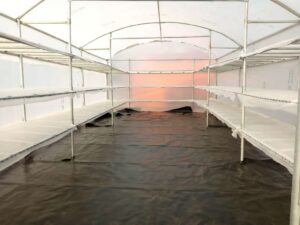
Water Harvesting With Dam Liners
Water harvesting with dam liners in Kenya is a an important aspect of effective and consistent all year round irrigation. Grekkon Limited is the largest provider of the 3 main types of dam liners in Kenya. This is for water harvesting and aquaculture to smallholder and medium commercial farmers. We encourage every commercial crop farmer to excavate a water pan for off-season production. We then line this water pan with geomembrane material to hold water. Dam liners prevent water loss in the reservoir through seepage into the soil below. Produce cultivated during the off-season fetches better prices, and ensures a consistent farm income. Our dam liners have anti-UV treatment to protect them from long-term solar degradation, which extends their lifespan
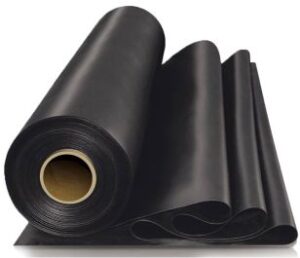
A roll of 0.75mm dam liner
Water Harvesting With Dam Liners
Steps:
- Work out the area under irrigation, or to irrigate
- Determine the irrigation method. Each method consumes different amounts of water. We recommend drip irrigation as the most water efficient method
- Understand how long the dry off-season period is
- The 3 workings above will give an indication of the water quantity needed
- Work out the size of the water pan to excavate to hold this amount of water
- Calculate the dam liner size to install in this water pan
An illustration
An acre of strawberry measures 4,048 meters square. The method of irrigation is drip, and strawberry require 100 cubic litres weekly per acre (averagely). The dry period lasts for 32 weeks, so the amount of water needed is 3.2million litres or 3,200 cubic liters to last this long. This assumes zero rainfall in these 8 months, and that there is a shade net covering to prevent evaporation losses
The reservoir dimensions are 36M length x 36M width x 2.5M depth. The total liner needed for this is 1,849 meters square
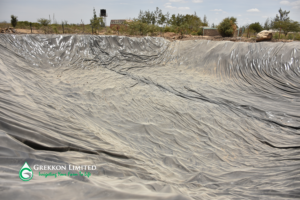
A newly excavated reservoir with a dam liner covering
Dam Liner Types In Kenya
1. By material
1.1. High density polyethylene (HDPE) geomembrane. These are the most common types because they have additional use in making urban multi-storey gardens
1.2. PVC dam liners. The are soft but heavy. This makes them easier to weld and install
1.3. Low density polyethylene (LDPE). They are soft and light, hence the least popular because they have a short lifespan
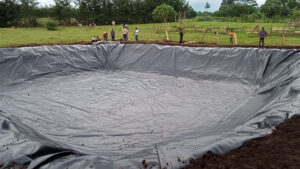
HDPE geomembrane pond lining
2. By size
2.1. 0.5mm / 500 microns. For smooth surfaces or soil with light murram particles. It has a lifespan of 15 years
2.2. 0.75mm / microns. For lightly stony or rocky surfaces. It has a life span of 25 years
2.3. 1mm / 1,000 microns. Applied on moderately stony or rocky surfaces. Period of use is 35 years
2.4. 1.5mm /1,500 microns. For application in difficult terrain where the others will not hold
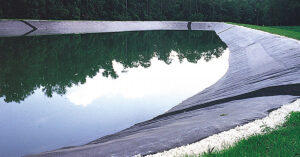
An irrigation water pan with dam liner material
Hybrid Solar Dryers For Sale In Kenya
Hybrid solar dryers for sale in Kenya by Grekkon Limited are active dryers designed to dry quicker, all year round. They are augmented units of the conventional passive solar dryers. The company has three types of hybrid solar dryers for sale in Kenya
- Solar powered. These units have a solar powering system that runs the extraction and exhaust fans. The fans provide better movement of air within the dryer, and removal of the moisture from the drying produce. This hastens the drying process
- Biomass powered. They have a biomass burning unit connected on the exterior. Biomass in the form of brickettes or charcoal heats water which produces steam that travels in tubes within the dryer. This heats up the air in the dryer, accelerating the dring process. Biomass powered dryers can be used at night or on cloudy, rainy or cold days when there is insufficient sunshine to dry
These hybrid solar dryers cost in Kenya ranges from Kes 135,000 to Kes 1,500,000. These hybrid solar dryers for sale in Kenya are for a carrying capacity of 100kgs through 1,000kgs
Hybrid Solar Dryers For Sale In Kenya
Solar Dryer Materials
- Light UV treated translucent polythene paper to allow heat and light. The paper also has anti-drip treatment to prevent dew formation which causes moulds to form on food
- Heavy UV treated geomembrane to conserve heat
- Steel bars galvanized with food-grade aluminum or zinc for food safety
- UV treated heavy gauge netting to prevent insect pests from entering

A hybrid solar dryerwith both an external biomass heating units, and a solar power system
Hybrid Solar Dryers For Sale In Kenya
I. What is hybrid solar dryer?
It is a conventional solar dryer that receives additional drying power from an external source. This could be biomass, solar or electricity
II. What are the three types of solar dryers?
- Natural / conventional solar dryers. These dry using only the power of the sun
- Forced / active dryers. They are augmented versions of the conventional solar dryers
- Portable or fixed solar dryers
III. How does a vegetable dryer work?
- Heat
They allow in diffused heat from the top and the sides, which heats up the air coming in from the air inlet. This hot air will exit with moisture in the air outlet.
- Anti-drip management
Our UV treated polythene cover has anti-drip properties so water droplets do not form on it. It prevents dripping on the drying food which is a precursor for fungal development
IV. What does a solar dryer do?
Grekkon Limited’s solar dryers reduce the moisture content to less than 12% in these products;
- Plantation crops; coffee, rice, cassava
- Vegetables; tomato, onion, garlic, brassicas, hot peppers
- Cereals; sorghum, and millet
- Herbs; moringa, mint, rosemary
- Oil crops; groundnuts, sunflower, macadamia, cashew nuts
- Others; mushrooms, fish, beef, mutton
V. How do you dry vegetables with solar?
- Wash the vegetables to remove all dirt
- Ensure there are no insect pests present
- Remove any diseased parts or produce
- Cut or grind them into smaller pieces to increase the drying surface area
Place them in the solar dryer holding trays

Dry cassava chips
VI. What is the most popular use of solar dryers?
To dry fruits, mushrooms, vegetables, herbs, spices, coffee, cassava, banana and fish. Banana and cassava are further processed into food flour. A solar dryer ensures that the food is free of any external contamination
VII. What are the main applications of a solar dryer?
Besides vegetables and fruits, commercial solar dryers in Kenya are for fish, root crops and mushroom drying. Commonly dried foods in Kenya through our solar dryers are:
i. Banana, cassava, pumpkin, millet, and sorghum to make food flour. Dried cassava is also processed for industrial starch manufacture
ii. Moringa as a medicinal herb
iii. Tomato, capsicum, traditional vegetables, kales, and spinach as vegetable nutrients
iv. Mango, papaya, as dried fruits for snacking
v. Omena which is the silver cyprinid fish for both human consumption, and as additive to animal feed
vi. Coffee so that it’s suitable for milling. Coffee solar dryers are the largest, each holding over 5 tons of berries per drying session
Where to buy dam liners in Kenya
Where to buy dam liners in Kenya is from Grekkon Limited. The company offers the best UV-treated black high density polyethylene (HDPE) dam liners manufactured for tropical climates. Our pond liners for sale in Kenya line the walls and floors of water harvesting reservoirs. This is to prevent water loss through seepage into the soil. Changing rainfall patterns and unpredictable seasons are increasingly becoming a norm in Africa. This is why the need for agricultural water conservation is growing amongst farmers. Every farmer practicing irrigation has a water source
Where to buy dam liners in Kenya
| Thickness | Weight per meter square in Kgs | Price per meter square in KES |
| 0.5mm | 0.46kg | KES 220 |
| 0.75mm | 0.88kg | KES 320 |
| 1mm | 0.91kg | KES 420 |
Water pans lined with dam liners are a source of irrigation water storage. This water is from a larger source such as a lake, river, or borehole water, and also harvesting rain and run-off water. Besides irrigation of your crop, the pond liners on your water pan allows for commercial or subsistence fish rearing; the former to boost household income, the latter to supplement household protein
Where to buy dam liners in Kenya
Dam liners are available in the companies 6 branches located in; Athi river, Nairobi, Kisumu, Eldoret, Nyeri and Nyahururu. We supply pond liners either as rolls of 110M x 8M, 0r cut and welded into the client’s water pan’s specifications

Dam liner rolls by Grekkon Limited
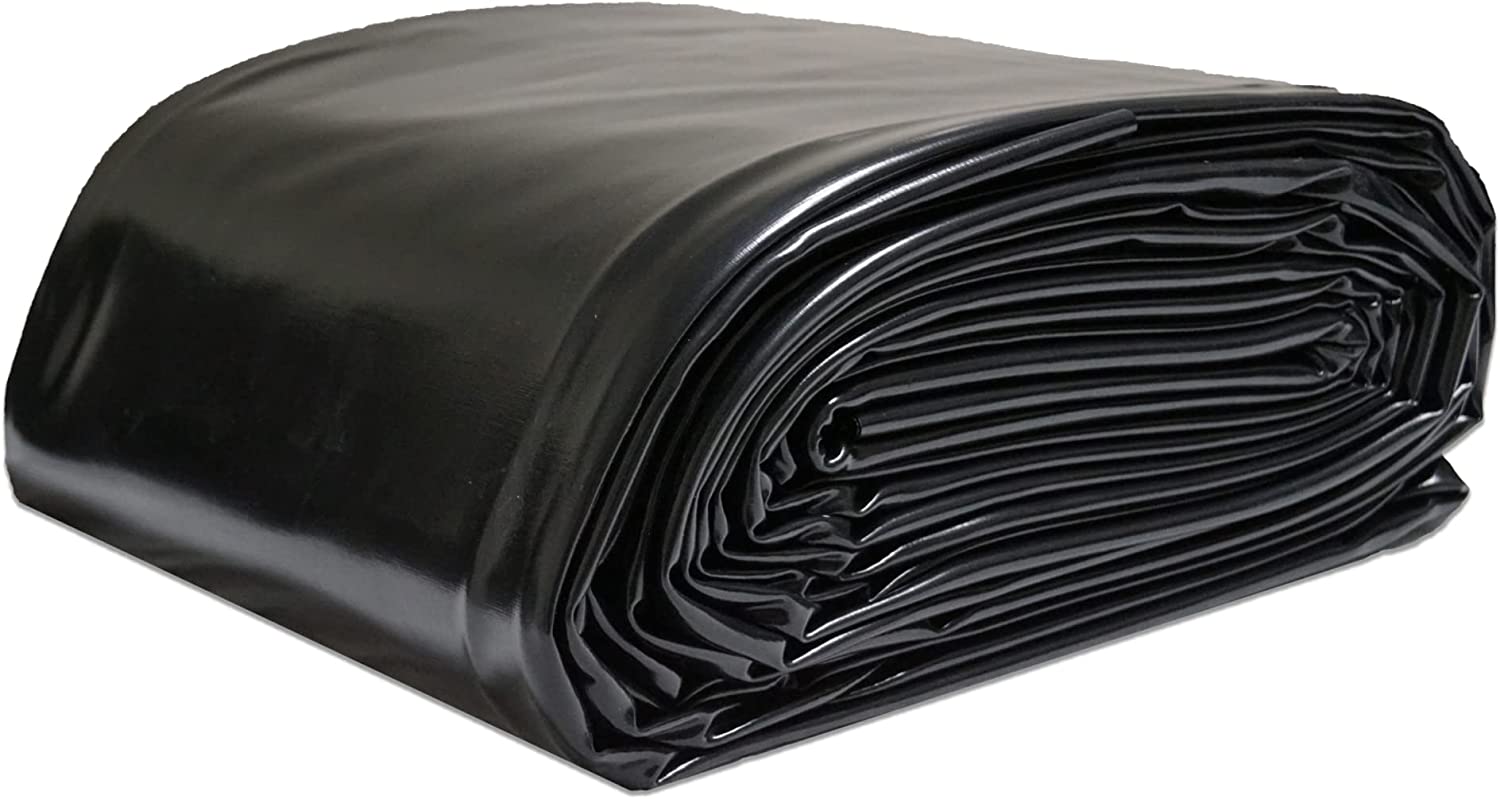
HDPE pond liners cut from a roll and welded to tailor it to the water pan dimensions
Where to buy dam liners in Kenya
Positioning Your Water Reservoir For Irrigation
This depends on:
i. The source of water going into the water pan. If the source is from a lower altitude water source such as a river or lake, the water pan is at an elevated position so that with a water pump, the water is reticulated through irrigation water pipes to the water pan. If the water source is from rain water falling on the roofs or run-off, the water pun is positioned at a lower gradient
ii. Preferred irrigation method. If by sprinkler irrigation or rain hose kits which require high pressure from a water pump, the water pan will be situated at any point. If by low gravity pressure say for drip or button drip irrigation, then it will be at the highest point of the farm

Water harvesting using dam liners
Where to buy dam-liners in Kenya
How to Harvest Water Using Dam Liners
Factors to consider
1. Land size
The amount of water required for half an acre is less than that needed for 20 acres. The latter will harvest more water to irrigate the greater acreage, and the former will have less water harvested. The bigger the volume of water reserved, the larger the dam liner size
2. Location
The amount of rain fall is different in every climatic zone. Growers in the cool wet highlands have just a few dry months in the year, while farmers in the dry zones have more dry months than wet. In regions where the interval between rains is long, larger reservoirs are built for the same acreage as that in the cool wet location. Again, dry locations have very high water loss through evaporation. In this case, it is advised to set up a shade net over the water reservoir to manage this water loss
3. Ground Elevation
The farm gradient determines the location of the water pan. Some choose to have it at the lowest part so as to capture run-off water. If it is for crop irrigation, this water is either pumped uphill to a tank from where it flows back by gravity to the crop. Or it is pumped directly to the crop from the water reservoir. Others choose to locate the water pan on the highest point of the farm so that the water, through gravity flows out to the crop. In this case, the farmer does not retain run-off rain water from the farm. On a flat terrain, irrigation water is physically pumped out to either a high storage tank for onward gravity flow to the crop. Or directly to the crop

A low reservoir that collects run-off rain water
4. Farming System
The size of the water pan will differ for irrigation, compared with aquaculture or livestock production
5. Crop Type
Some crops are more water demanding such as leafy vegetables, than others such as herbs. Then some crops like onion are densely spaced while others are like avocado are sparsely populated in the farm. This will determine the water requirement
6. Irrigation System
Every irrigation system has it’s own unique water use. Drip irrigation conserves water while overhead irrigation through sprinklers or rain hose kits spends huge water volumes
7. Surface Texture
The surface texture of the water pan determines the dam liner thickness to install. For a smooth surface, a 0.5mm dam liner is ok. Where the surface is stony or rocky, then the 0.75mm or 1mm dam line is better
Before harvesting your water using dam liners, ensure that the water pan’s surface is free of debris as much as is possible. This will be stones, rocks, tree stomps, or sticks. This reduces the danger of your dam liner tearing as a result of perforation caused by the weight of the water squeezing the material against these particles
Trench 0.75M to 1M along the perimeter or circumference of the water pan. This trench is 1ft wide and 2 ft deep. Your dam liner edges will be tucked in here and covered with soil, gravel or stones to anchor it in place. Alternatively, use sand bags along the edges to hold your dam liner in place
Where to buy dam liners in Kenya
How Are Dam Liner Sizes Calculated?
Before determining the dam liner size, one must understand the size of the reservoir or tank. This is by measuring the length, width, and depth/ height (for rectangular or square shaped reservoirs/ tanks). For circular or cylindrical tanks/ reservoirs, measure the diameter, and the depth/ height. The reason this is key is because our dam liner material comes in rolls. To make out the shape of the water pan or tank, the dam liner is cut in large bits from the roll and joined together. This is to create the 2 dimension size of the water reservoir or tank. For example; if the width of the dam liner on the roll is 8M, and the water pan requires a width of 15M. Then 2 pieces, one measuring 8M and another 7M in width from the roll are cut and joined to create the 15M width
How Do I Calculate How Much Dam Liner I Need?
The dam liner calculator is adapted to the shape of the irrigation water reservoir as illustated in the 3 different shapes below
- Sloped sides reservoir

The slope of the dam wall is shown as slanting length (SL) or slanting width (SW) in the dam liner calculator tabulation shown later in this page
2. Cylindrical circular tanks
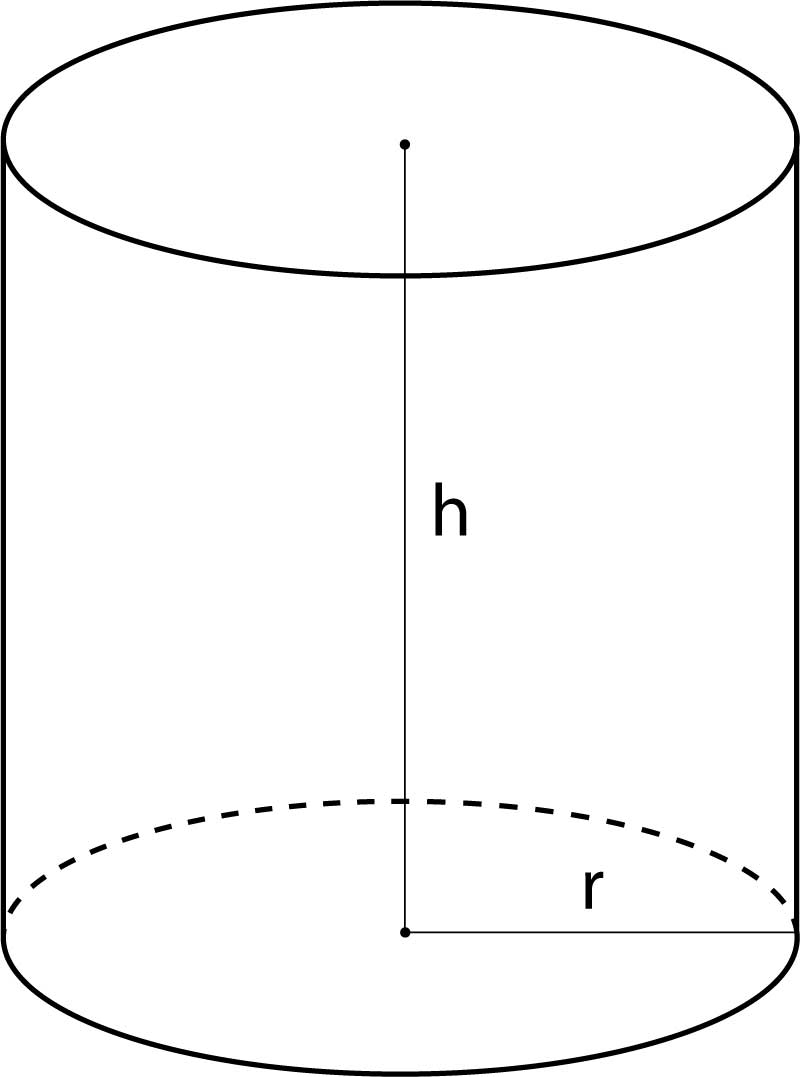
3. Straight side reservoirs
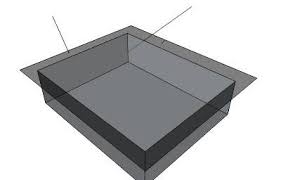
Where to buy dam liners in Kenya
Pond Liner Calculator Table
| Circular Liner | Sloped Sides Liner | Straight Side Liner |
| (Circumference*H+0.6M) + (3.14*3.14*r+0.6M) | (SL*2+D+2M)*(SW*2+D+2M) | (L+2D+2M) * (W+2D+2M) |
If your totals include a decimal say 120.3sq, round it up to the nearest whole number, in this case 121M sq. The +0.6M in the ‘circular liner’ and is the overlap. So is the 2M in the straight side liner’
“D” is the maximum depth which is the center-most point of the reservoir
Where to buy dam liners in Kenya
How much overhang should a pond liner have?
An overhang is the extra liner material that holds the main liner in the reservoir or tank. This excess material is held against the external wall of the tank, or tucked in a trench all around the reservoir to support the dam liner in place. It is covered with soil or stones in the trench. Another alternative to trenching is to lay sand bags on it. The weight of the sand bags holds the dam liner in place
After excavation, it is necessary to compress the mould of soil roundabout the water pan before making a trench
See below
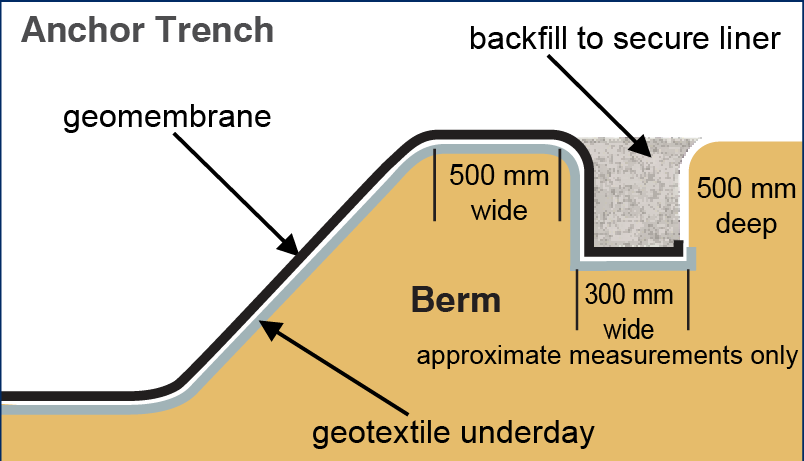
Where to buy dam liners in Kenya
How To Weld Dam Liners
- Factory welding. Depending on the dam liner size, weld it whole or partially in the factory. The weight and volume of the welded material must be easily portable on site. The latter factor guides on how much of the dam liner material will be put together in the factory
- Site or field welding. This is done on site at the point of dam liner installation. It is the joining together of the partially welded dam liner pieces from the factory. Site welding is done when the entire dam liner could not be wholly put together in the factory. This is as a result of weight or bulkiness, which limits lifting and transportation of the bulky and heavy material. The weight size of the portable material depends on the thickness of the dam liner. The thicker it is, the less it is
- A wedge welding machine or a heat gun/ heat blower is the equipment that does dam liner welding. A wedge machine is what does it in the factory. The heat gun is highly portable, and so is best for field joinery
Dam liner welding involves melting the liner material under high temperature at the point of joining them. Once melted, the 2 layers are laid one over the other and as they harden, become one unit
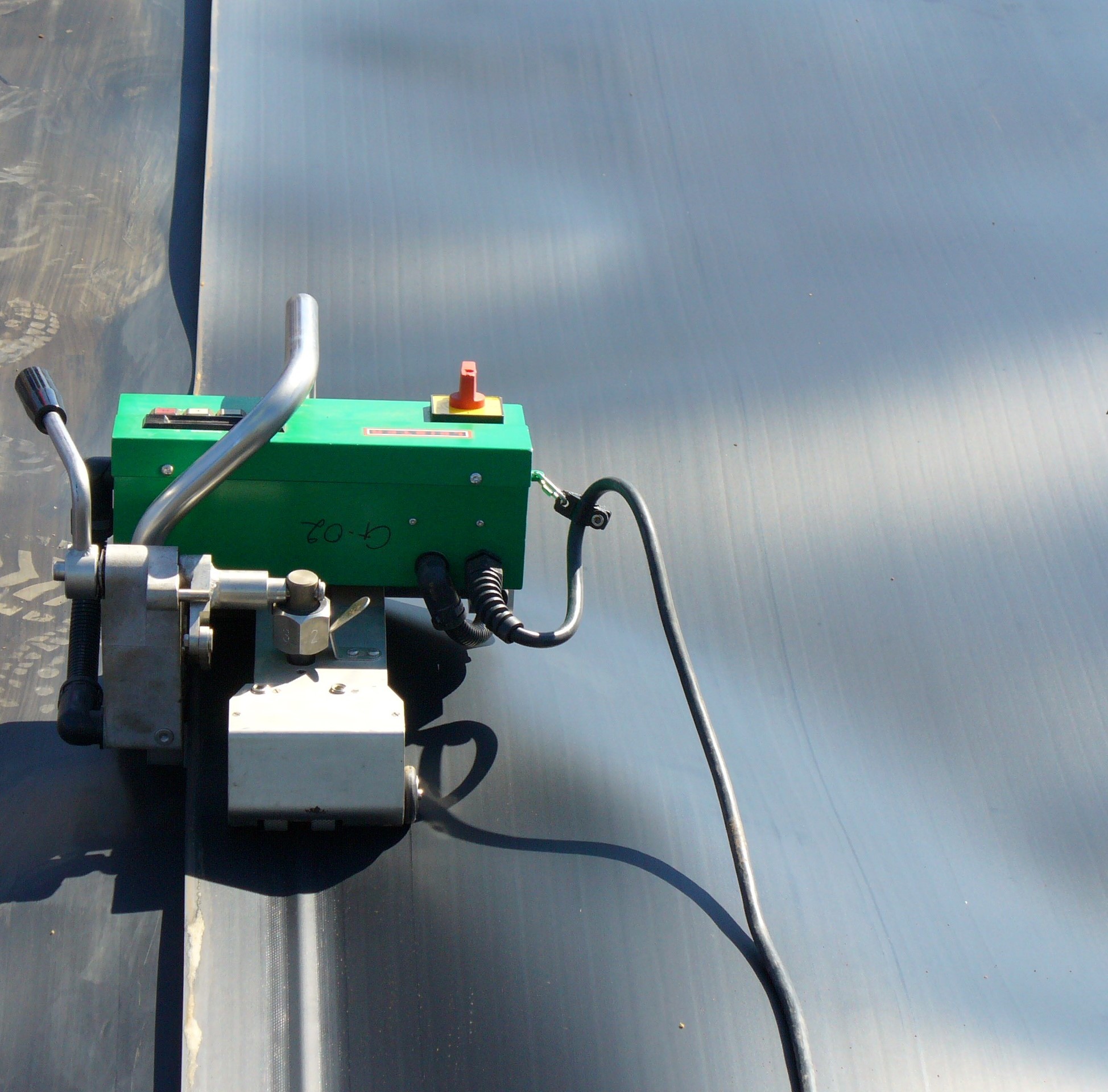
Factory wedge welding of a 1mm thick dam liner

Joining 2 dam liner pieces with a heat gun
Both equipment run on electric power. In off grid electricity locations, Grekkon Limited provides a generator to power the heat gun or wedge welding machine
Where to buy dam liners in Kenya
A Step by step procedure on how to install dam liners
To learn how to install dam liners in your water pan or tank, consider the following factors
- Determine if;
1.1. It is a water reservoir
or
1.2 A water tank
Each storage unit has a different way of calculating the dam liner
2. Define the shape of the water pan or tank;
2.1. Is it circular/ oval or square/ rectangular?
2.2 Are the rectangular/ square sides steep or slanted?
The dam liner calculation formulae is different for each shape as illustrated later in this article
The second stage in how to install dam liners is to work out the dam liner size

A Grekkon Limited technician installing a dam liner in a water reservoir

